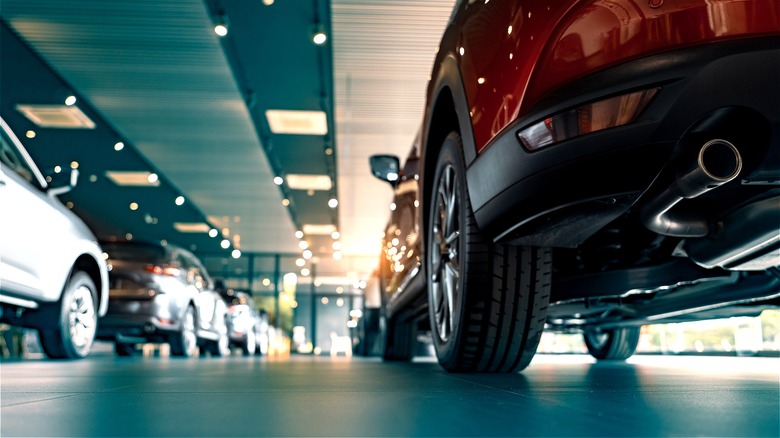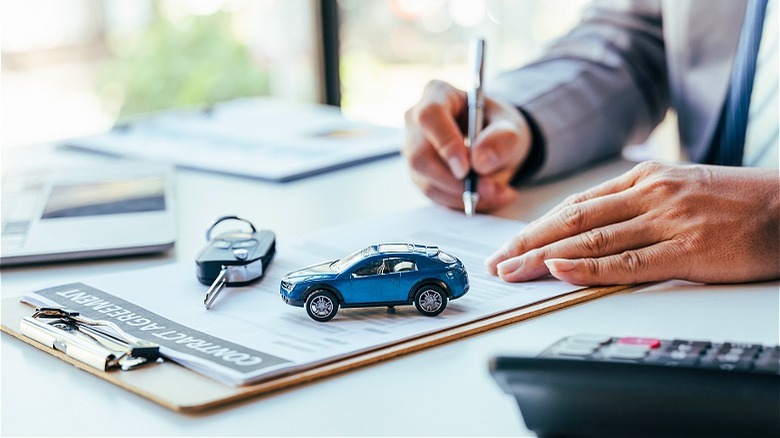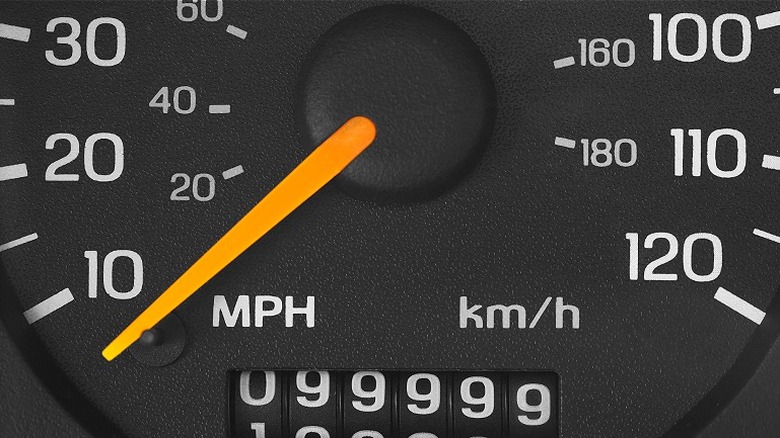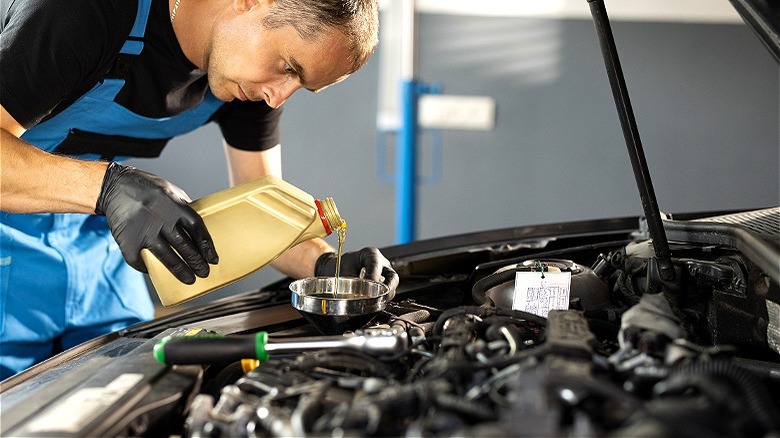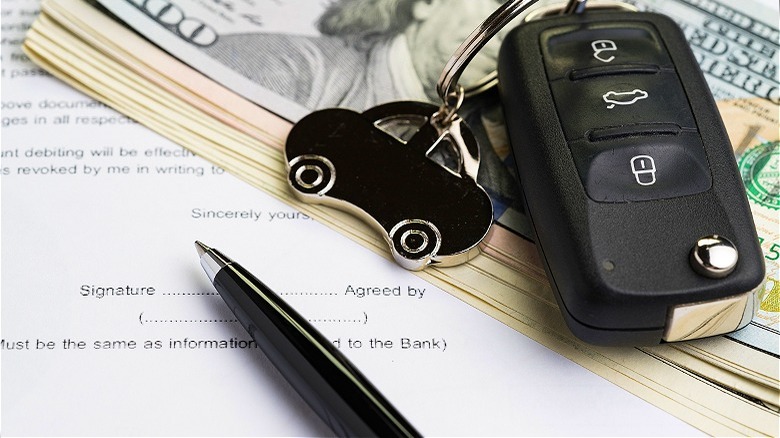How Exactly Does A Car Lease Work?
Kelley Blue Book reports the average new car price in December 2022 was a whopping $48,247. If you're in urgent need of a new set of wheels but low on funds, leasing can be an alternative to buying a car brand new. That's especially true if you prefer to continually drive late-model vehicles that are reliable, have the latest in safety and technology features, and are fully covered by a manufacturer's warranty.
Although leasing has been around in some form for over a century, its peak popularity was in the early 2000s, when approximately 30% of all new cars were leased rather than purchased. Since then, low (or even 0%) interest rates on auto loans following the Great Recession reduced the desirability of leasing versus buying, but auto leasing is making somewhat of a comeback, particularly in the burgeoning electrical vehicle segment of the market.
Like an extended version of renting a car on vacation, auto leasing is an arrangement where you're paying to use the vehicle for a set period of time, typically two to four years. During that time, you'll make monthly payments like you would on a loan, but when the contract period is over, you won't own anything. As a consolation for not owning, lease payments are typically much lower than loan payments. Also keep in mind that most newly purchased vehicles depreciate in value considerably over their first several years, anyway. Since new cars are depreciating assets, and a necessary evil, leasing is indeed a viable alternative to buying.
How the math in car leasing works
You might be wondering how exactly lease payments can be lower (in most cases) than car loan payments, particularly on luxury cars like BMW, Mercedes, and Lexus. Leasing companies — which are often owned by the automaker themselves — calculate what they call a residual value. That represents the value of the vehicle at the end of the agreed-upon lease period.
For example, let's say you're purchasing a $42,000 car today and the leasing company's financial model determines it'll be worth $30,000 three years from now. That $12,000 difference, plus taxes, fees, and interest (called "money factor" in auto leasing terminology), is divided by 36 months to determine the monthly lease payment. That's in contrast to buying the vehicle outright, where the entire $42,000 purchase price is divided by the length of the loan. That's how the lease magic happens.
While car leases are often advertised based solely on a monthly payment amount, potential lessees should know the terms are actually quite negotiable. To begin with, the purchase price of the vehicle may be subject to haggling, just as if you were buying it. Additionally, many of the monthly lease payments you see advertised factor in a large down payment. In the language of the leasing world, your down payment is called a "capitalized cost reduction" and it's entirely negotiable, with a higher upfront payment leading to smaller monthly payments and vice-versa if you're short on cash for a down payment at the moment.
Leases have many moving parts
Besides the purchase price and down payment amount, the duration of the lease is also adjustable to suit the needs of the lessee. For instance, an advertised 36-month lease can be priced instead as a 30- or 42-month lease using revised residual values that the leasing company provides the car dealership. Ditto for the number of miles you're allowed to drive the car. Typically, drivers of leased vehicles are permitted to drive 10,000 to 15,000 miles each year. For example, a 36-month lease might have an upper limit of 36,000 miles. Like other aspects of a lease, the allowable mileage is also negotiable.
If you think you're going to accumulate considerable mileage on your leased car, it's preferable to have this factored into the lease terms up front. The lease payments for driving 15,000 or more miles per year will be slightly more expensive than a 10,000-mile-per-year lease because a high-mileage vehicle will have a lower residual value (i.e., be worth less) at the end of the lease than a low mileage vehicle. Still, this is a far cheaper alternative than paying for the excessive mileage in the form of a penalty at the end of a lease, which can range from 10 cents up to a whopping 50 cents per mile.
You'll need to keep the vehicle in good condition
At the risk of overcomplicating the car-leasing process, a few other nuances of leasing include the presence of disposition fees that may be due when turning in a vehicle at the end of a lease, as well as putting up a security deposit to cover damage. A leased vehicle will undergo an inspection shortly before the end of the lease and if significant cosmetic or mechanical damage is found, like dents or rips in the upholstery, expect to be charged a penalty against your security deposit.
Finally, you'll want to know who's responsible for maintenance of the vehicle, such as oil changes. Policies vary by brand, but as an example, BMW and Hyundai both provide free maintenance for the first three years or 36,000 miles of a lease while General Motors vehicles only include a single free maintenance visit.
Note that it is typically difficult and/or expensive to end a lease early. If you don't like the vehicle, move to an area where a car is unnecessary, can't afford the payments any longer, or any number of other reasons, it could cost thousands of dollars in fees and penalties to break the lease. Additionally, a leased vehicle will typically require higher levels of insurance coverage than you might normally opt for, resulting in higher rates.
You could be on a payment treadmill
At the end of a lease, lessees have the option to turn in their vehicles with no further obligation, at which point they can lease or purchase another car or go without. Alternatively, lessees can usually opt to purchase the vehicle at a cost that was set when the lease was originally signed. Depending on market conditions and other circumstances, the ability to buy a car in the future for a predetermined price can be advantageous. For example, during the COVID-19 pandemic, spiking used car values made purchasing a vehicle at the end of an existing lease an attractive proposition.
In summary, the monthly payments involved with leasing are typically lower than owning since you're only paying for the amount of time you'll be using the vehicle. Also, you'll potentially be able to afford to drive a more premium vehicle than if you were buying instead.
However, leasing a vehicle can be more expensive than buying one in the long run. That's because you'll be caught in a cycle — some might call it a "trap" — of forever making monthly car payments without actually owning anything. That said, leasing can be an option for drivers who want to own a fresh new vehicle every few years without the hassle of continuously trading-in their cars, which is an expense in its own right.
